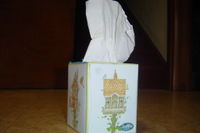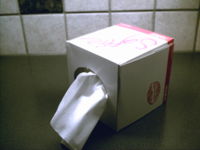Facial Tissue


Cellucotton was first used as a substitute for cotton during World War I for wound dressings and gas mask filters. [1] Cotton as a natural raw material was in high demand for medicinal purposes among other things during this period. After the war, and some compositional changes, Kleenex (the first facial tissue) came to market as a makeup remover.
It wasn't until 1930 that the marketing focus of Kleenex changed to that of a disposable handkerchief. In most parts of the world, handkerchiefs have fallen out of use, except for fashion, and their function has been replaced entirely by facial tissue. More than just a handkerchief, today's facial tissue is now designed to alleviate and prevent discomfort and sickness by facilitating the expulsion of nasal mucus from the nose ("blowing the nose").
The tissue is a disposable type of paper engineered to be thin and soft for comfort, but extra sturdy for function. Because extraneous mucus is an annoyance, facial tissue is a widely used item in households worldwide.Facial tissue is often referred to as a "tissue" or by the genericized trademark "Kleenex" which popularised the invention and its use.
The term "paper handkerchief" is also used.Sometimes toilet paper is used as a substitute, as it is very similar. However, because toilet paper is designed to deteriorate in water, it is much less sturdy, increasing the potential of mucus reaching the hands. Furthermore, some brands of toilet paper are relatively rough and may irritate the nose, although not as badly as paper towels.
